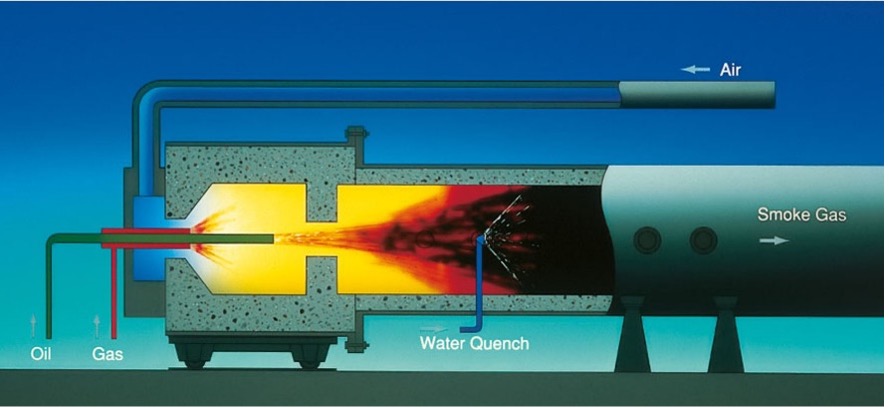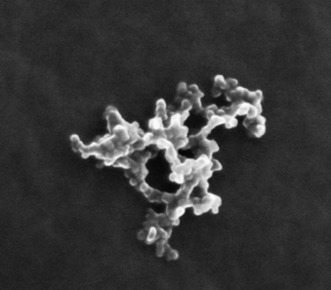Production, Regulatory Concerns, & Environmental Impact
Part 1 of our series considering the impact of recently proposed New York legislation to ban carbon black in packaging defined the substance and its uses. In this second article we will dive into production, health, and regulatory concerns. You can review Senate Bill 2023-S4246A, The Packaging Reduction and Infrastructure Act which identifies carbon black as a toxic substance.
Over time several methods have been developed to produce carbon black depending on the state of technology as well as the resources in geographical areas. The furnace black process is the most efficient and widely used process today, but we will discuss others as well.
Furnace Black Process
This process uses hydrocarbons from oil and natural gas as raw materials and produces most of the world’s carbon black. Feedstocks are injected into a reactor to undergo thermal decomposition. However, they are only partially combusted in temperature and oxygen controlled environments. In this controlled reaction, carbon black particles are generated and collected. In today’s reactor systems, it is possible to surface treat the pigment as it’s being generated to enhance performance properties for specific applications (i.e., pigment dispersion and ink making).
The carbon black is a powder form of agglomerates with primary particle size ranging from 10 to 80nm. The powder may be pressed into pellets for ease of handling. In addition to surface treatment modification, process conditions can be modified to control properties such as structure and surface area.

Figure 1. Furnace black process. Orion Carbons
Thermal Black Process
The thermal black process entails pumping natural gas into a preheated furnace under inert conditions. The gas then decomposes to carbon black and hydrogen. The resultant carbon black forms slowly in the absence of oxygen producing particles which are typically very pure, with larger particle size and less structure versus furnace black. The process uses a pair of furnaces. While one is being preheated, the second is decomposing natural gas to carbon black. The hydrogen off-gas from the decomposition process can be used to preheat the second furnace for the next batch in this discontinuous process.

Figure 2. Thermal Black Process. Beilum Carbon
Gas Black Process (Degussa Process)
The gas black process was developed in Europe utilizing coal tar distillates. The oil is essentially heated until it vaporizes. The pure vaporized oil is carried to a combustion chamber by a hydrogen rich carrier gas. As oxygen is present, the carbon black produced with have a high degree of functionality on its surface made up of oxygen functional groups. This process produces high purity, small particle size carbon black. Like furnace black, the properties of the gas black make it ideal for inks and coatings.

Figure 3. Electron microscope image of gas black particle. Orion Carbons
Other historical processes of producing carbon black include lamp black, channel black, and the acetylene black process. If you want to generate some carbon black yourself, it’s quite simple. Place a steel pan of cold water above a candle but within the orange flame. You will capture partially combusted wax in the form of carbon black on the bottom of the pan. Essentially if you light candles, grill, burn incense, or use citronella candles to battle mosquitoes, you’re making carbon black.
Regulatory Concerns
When we talk about regulatory concerns related to carbon black, a critical distinction needs to be made up front. Are we talking about carbon black as a pigment in its dry powder form or are we referring to carbon black present in a dry ink film? Let’s first look at carbon black as an ink manufacturer receives it, in powder form.
Health Risks
The biggest concern with carbon black is the potential for a dust explosion if not properly handled. Should you generate a dust cloud with a concentration of more than 50 grams per cubic meter, there is risk of an explosion or combustion in the presence of an ignition source. With good housekeeping and care in eliminating ignition sources, this risk is minimized.
A secondary concern would be that of inhalation. Carbon black pigment has a very small particle size and will spread very easily if not covered. Short term exposure to carbon black dust via inhalation dust may be irritating and produce upper respiratory discomfort. This may result in coughing and wheezing. But there is no evidence that acute exposure is life-threatening.
Prolonged inhalation studies of carbon black in animals conducted to the point of “lung overload” led to inflammation. Although inflammation may lead to genotoxic effects, the carbon black was not itself considered to be mutagenic. Further, these results were similar to studies on “poorly soluble inorganic particles” in other inhalation studies. Because long term exposure to carbon black and other poorly soluble particles leads to a decline in lung capacity, personal protective equipment (PPE) and good occupational hygiene practices are always encouraged when working with carbon black powder.
Carbon black is not considered an irritant to the eyes or skin. Mechanical irritation can occur and carbon black, like other powders, may dry out the skin.
The International Agency for Research on Cancer (IARC) has classified carbon black powder as a Group 2B carcinogen. The International Carbon Black Association argues the basis for this classification was based on laboratory rats uniquely sensitive to high doses of inhaled low solubility particles. There is insufficient evidence to conclude an association exists between carbon black and lung cancer in humans. The nonprofit American Conference of Governmental Industrial Hygienists (ACGIH) has concluded that carbon black is a confirmed animal carcinogen with unknown relevance to humans.
Once carbon black is formulated into an ink or coating, all the risks associated with it as a “poorly soluble particle” are eliminated. This is an important distinction and seems to have been missed in the senate bill which erroneously references carbon black as a toxic substance. The director of regulatory affairs and technology for NAPIM, George Fuchs, shared, “We are very concerned about this and have joined forces with multiple trades and business organizations to oppose this poorly thought out, counterproductive legislation.”
Environmental Impacts
It is estimated that between 29 and 79 million metric tons of carbon dioxide is emitted during the production of more than 15 million metric tons of carbon black. There is potential to reduce the carbon footprint by 19% if hydrogen was used instead of natural gas. Other potential environmental impacts include the release of carbon monoxide, volatile organic compounds, sulfur oxides and nitrogen oxides. The release of particulate emissions (carbon black) due to poor product recovery is also a risk, however, emissions have been significantly reduced over the past 30 years due to the introduction of high performance filtration systems.

Figure 4. Inks made with biomass-derived carbon black. Ecoenclose.com
As we have discussed, carbon black pigment is produced mainly from petroleum distillates. Carbon black has been produced from waste material like tires and there are companies who are now producing carbon black from renewable resources. Living Ink produces carbon black from biomass waste in a process which carbon negative. They have already refined the process for producing screen inks, offset, and flexographic inks. It’s likely we will see inkjet grades in the not-too-distant future. Biomass derived carbon black pigments are produced by combustion in an oxygen restricted atmosphere like traditional carbon black. Unfortunately, these renewable forms of carbon black would also be banned by the proposed state legislation.
In Part 3 in our series on carbon black we will look at potential substitutes for carbon black and impacts on inkjet.

